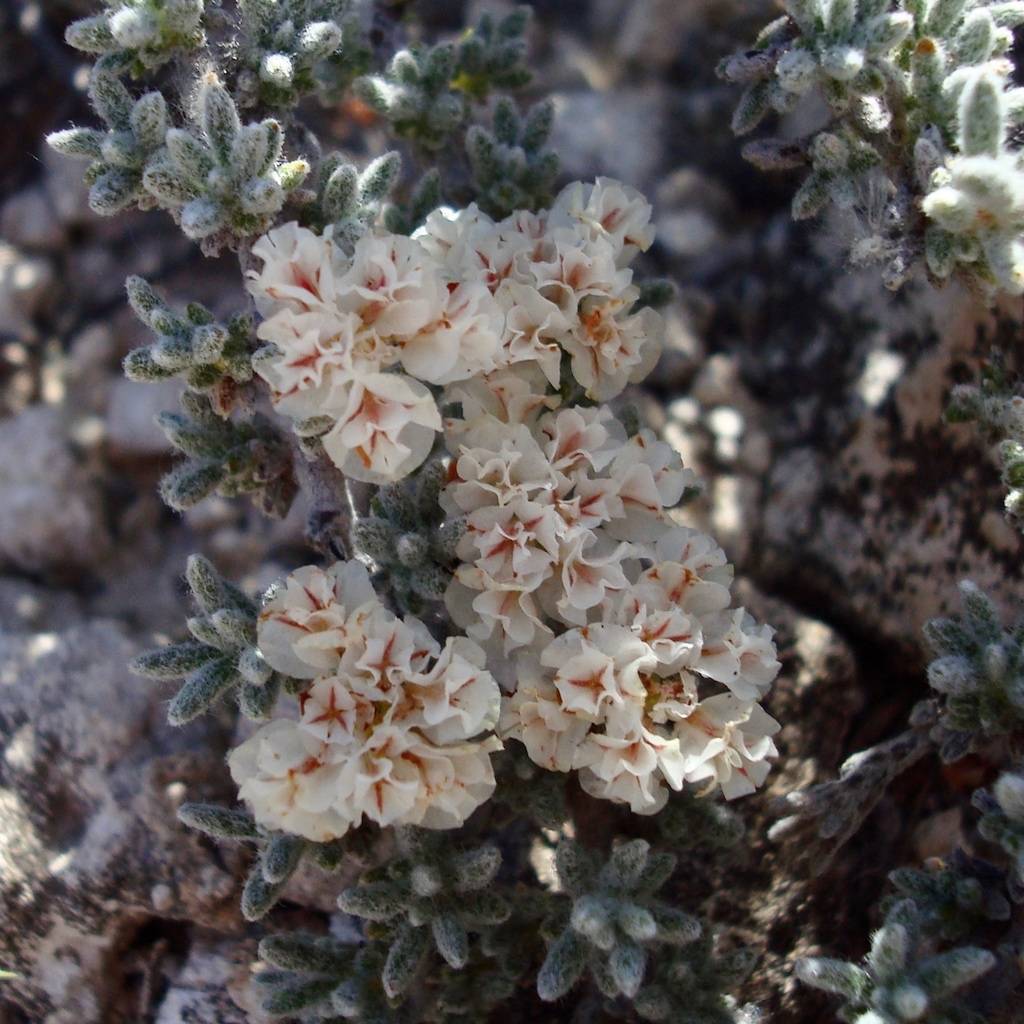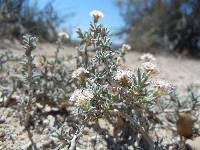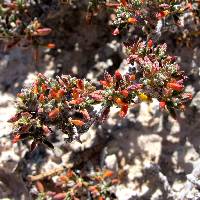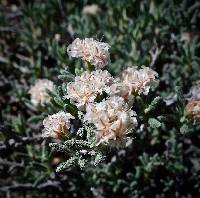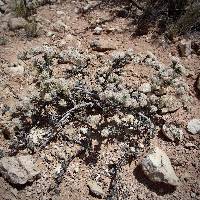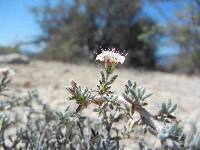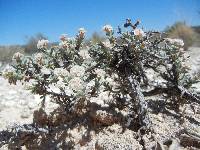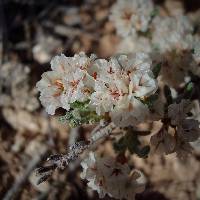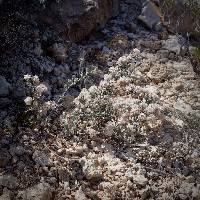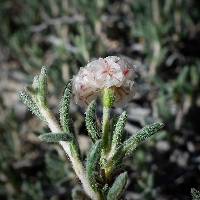Eriogonum ripleyi
|
|
|
|
Family: Polygonaceae
Fraziers Well buckwheat, more...Fraziers Well Wild Buckwheat, Frazier well buckwheat
|
Subshrubs, sprawling to decum-bent, occasionally scapose, 0.5-2.5(-4) × 0.5-5(-7) dm, grayish-tomentose. Stems decumbent to slightly spreading or erect, often with persistent leaf bases, up to 4 height of plant; caudex stems absent or compact; aerial flowering stems spreading to erect, slender, solid, not fistulose, 0.05-2.5(-3.5) dm, tomentose. Leaves cauline, 1 per node or fasciculate; petiole 0.05-0.15 cm, villous; blade narrowly oblanceolate, 0.2-0.6 × 0.05-0.1 cm, densely white-tomentose abaxially, thinly floccose to villous adaxially, margins revolute. Inflorescences cymose-umbellate or capitate and reduced to single involucre; branches usually dichotomous, sometimes with secondaries suppressed, occasionally absent, tomentose; bracts absent. Peduncles erect, 0.1-1.5 cm, thinly floccose. Involucres 1 per node, campanulate, 3-3.5 × 3-3.5 mm, thinly floccose or villous to subglabrous; teeth 3-5, erect, 0.7-1 mm. Flowers 3.5-4.5 mm; perianth white, glabrous; tepals connate proximal 1/ 5, dimorphic, those of outer whorl nearly orbiculate, 3-3.5 mm wide, those of inner whorl broadly obovate, 2-2.5 mm wide; stamens long-exserted, 4-5 mm; filaments villous to densely pilose proximally. Achenes light brown, 2-2.5 mm, glabrous. Flowering Mar-Jun. Sandy clay flats and slopes on edge of sandstone outcrops, oak-juniper woodlands; of conservation concern; 1000-1900 m; Ariz. Eriogonum ripleyi is known only from two areas in Arizona, one near Frazier's Well in Coconino County and a second in the Verdi Valley area of southeastern Yavapai and extreme northwestern Maricopa counties. The species is worthy of cultivation. Ripley's wild buckwheat is considered a 'sensitive' species in Arizona.
FNA 2005, Kearney and Peebels 1969 Duration: Perennial Nativity: Native Lifeform: Subshrub General: Herbaceous perennials, stems to 70 cm long, sprawling to decumbent, occasionally scapose, herbage grayish-tomentose. Leaves: Alternate or whorled, narrowly oblanceolate, 2-6 mm long and 0.5-1 mm wide, densely white-tomentose below, thinly floccose to villous above with revolute margins, petioles villous and 0.5-15 mm long. Flowers: White and glabrous, the flower-like perianth 3.5-4.5 mm long, tepals connate at the base approximately one-fifth of its length, those of outer whorl nearly orbiculate and 3-3.5 mm wide, those of the inner whorl broadly obovate and 2-2.5 mm wide, stamens long-exserted, 4-5 mm long, filaments villous to densely pilose proximally, inflorescences cymose-umbellate or capitate and reduced to a single involucre, branches usually dichotomous, sometimes with secondaries suppressed or occasionally absent, tomentose, bracts absent, peduncles erect, 0.1-1.5 cm, thinly floccose, involucres campanulate and 1 per node, campanulate, 3-3.5 mm long and wide, the surfaces thinly floccose or villous to subglabrous, with 3-5 minute, erect teeth to 1 mm long. Fruits: Achenes light brown and 2-2.5 mm long with glabrous surfaces. Ecology: Found on sandy clay flats and slopes on edge of sandstone outcrops, in pi-on pine and oak-juniper woodlands; of conservation concern, from 3,500-6,500 ft (1067-1981 m); flowering March-June. Distribution: Arizona only. Ethnobotany: Specific uses for this species are unknown, but other species in the genus have uses; plant used for severe pain in hips and back, hemorrhage, menstruation medicine, to expedite childbirth, for internal pains, especially stomach pain, general indisposition, syphilis, infusion of plant taken to shrink the uterus and reduce dysmenorrhea, infusion of flowers used as an eyewash, to clean out the intestines, infusion of flowers and leaves used as a mouthwash for pyorrhea, leaves, growing near the root, used as a physic, salve of dry leaves or leaf ash mixed with grease used for swellings, decoction of roots taken for diarrhea, heart medicine, plants used in steambath for rheumatism, stiff and aching joints and muscles, and shoots and seeds used for food, stems used to brush off spines on fruits. Synonyms: None Editor: LCrumbacher2012 Etymology: Eriogonum comes from the Greek erion, "wool," and gonu, "joint or knee," in reference to the hairy or woolly joints of some of the species of the genus, and ripleyi is named after Harry Dwight Dillon Ripley (1908-1973), linguist, plant collector, artist and author, born in London, began his plant collecting in Northern Africa and Spain with his friend Rupert Barneby, with whom he attended school at Harrow. |
|
|
|

